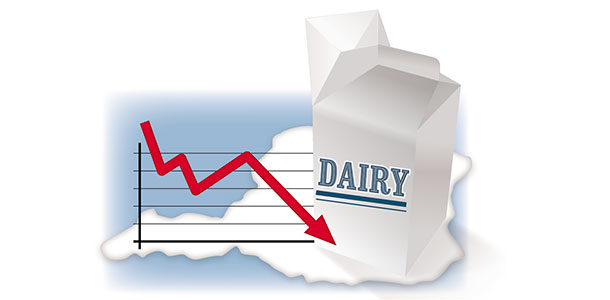What does your marketing plan look like for 2015? As I write this, April 2015 Class III milk futures prices are trading in the neighborhood of $14.40 per hundredweight (cwt), $10 less than the September 2014 Class III peak of $24.60 only seven months earlier.
We all want to forget the $10 Class III price crash that occurred from June 2008 to February 2009, but can we? The eight consecutive months of Class III prices below $12 at the bottom of that cycle caused the real damage to dairy farm balance sheets during 2009. What can we learn from history?
Milk prices continue to ride the roller coaster that is becoming a normal part of the dairy industry in the U.S. Last summer, we saw that when the demand for dairy products, especially butter, grew more than the supply, prices climbed quickly and dramatically. Today, we are witnessing what happens when the world supply of dairy products surpasses consumer demand around the world.
Dairymen are concerned that dairy exports from the U.S. are slowing down as the dollar strengthens against other currencies, even though exports are still well above 2012 levels. Milk production quotas are ending in Europe as these countries struggle to maintain economic growth. Dairy product inventories and cow numbers are increasing here in the U.S. as our cows continue to produce more milk.
The positive signs for the dairy industry include feed costs that are much lower than they have been in recent years. High cull cow prices should quickly reduce the U.S. dairy herd as farms respond to these low milk prices. Consumer confidence is steadily increasing in the U.S. as our economy continues to grow. Over the long term, consumers across the globe expect to improve their diet by eating more dairy products.
Using the USDA’s Margin Protection Program forecasted margins as a barometer, margins may drop below $7 for several months from March through July, but today’s futures markets anticipate a recovery to more than $9 margins by next fall at $16 Class III milk prices.
In today’s lower-feed-cost environment, we need to look at the margin to gain perspective on what a “good” milk price is. The highest monthly MPP margin since 2000 was $15.62 in October 2014 with an all-milk price of $24.90 and a ration cost of $9.28 per cwt.
If we assume that feed costs remain steady at this level, an all-milk price of $17.28 would yield an $8 margin. An average basis of $2 would convert this $8 margin to a Class III price of $15.28. Why would we even consider protecting a Class III price that is $9 per cwt below last September’s $24.60 close?
Because that price may still provide a solid base to a marketing plan in today’s environment. The average of monthly MPP margins since January of 2000 is $8.26. Since January of 2010, the monthly average is $7.39.
A substantial number of farms proactively took advantage of the milk pricing opportunities that were available last fall and summer to secure serviceable margins for much of 2015 with futures contracts, LGM-Dairy and the Margin Protection Program. These farm businesses are actively working to preserve the equity that they built over the past year, not allowing it to burn up in an unexpected downturn.
On Jan. 1, 2013, open interest on the CME listed 12,203 Class III contracts for the first six months of that year signifying almost 2.5 percent of the total U.S. production for those six months. Jan. 1, 2014 registered 16,987 Class III contracts covering 3.3 percent of total production.
On Jan. 1 of this year, Class III open interest had doubled from two years earlier with 27,685 contracts representing 5.3 percent of the expected milk production for the first half of the year. These levels are well below the volume of corn and soybean futures contracts, but dairy managers are learning how to employ futures and option contracts to mitigate their price risk.
Livestock Gross Margin Insurance for Dairy sales this fall were also very strong due to the same robust Class III futures prices. More than half of the dairy farms in the U.S. built a strong marketing plan foundation by registering for the USDA’s Margin Protection Program at some level last fall.
We never see the events that dominate price and margin upswings or crashes until after they happen. What are Joe Dairyman’s risks? The banking crisis in 2009 and the drought of 2012 decimated balance sheets on dairy farms across the country, but no one included these events in their six-month price outlook.
A crop failure domestically or internationally, caused by drought, flood, frost or any other reason is the greatest risk to profitable margins. This could raise feed costs and squeeze our margins in the U.S., but a drought in New Zealand or Europe could reduce their milk production, increasing the domestic demand for dairy products.
International political events can have the same unpredictable positive or negative effect on Joe’s milk check. This is why a sound marketing plan can protect at least a portion of the farm’s production to maintain cash flow during the price troughs.
Last September’s futures markets projected MPP margins to be around $9 this spring. Today’s $7 estimates for MPP margins from March through July demonstrate that focusing your marketing plan solely on the outlook is risky because outlooks change constantly.
A sound marketing strategy that protects some portion of a farm’s production when the market presents profitable margins, regardless of the outlook, will protect cash flow when the price fundamentals change.
Many farms began their 2015 marketing plan last fall. Producers who registered for the Margin Protection Program or bought Livestock Gross Margin insurance for Dairy have some basic protection against escalating feed costs and decreasing milk prices.
The larger dairy contract volume on the CME will also enhance additional dairymen’s milk checks as we move through the year. Dairies that grow a portion of their own feed needs have a natural hedge against a feed price spike, and they can buy crop insurance this spring to provide another level of security on the feed cost side.
Almost all commodity prices have fallen drastically over the past year. Oil prices fell in half since last year, dropping farm fuel costs. The S&P GSCI commodity index which serves as a benchmark for commodity market investments over time is at 2009 levels.
My point is that while a $16 Class III price may not seem appealing after last summer’s record highs, if feed and fuel costs are also protected, a $16 Class III milk price could provide a reasonable margin when you know and manage your costs.
Do not panic because milk prices have fallen. Every experienced dairyman knows that a bad situation will only get worse if you lose your composure while working around dairy cattle.
Effectively managing milk margins requires the same cool, calm composure during volatile markets that you exhibit as you sort those pens that should not be mixed up or display to that first-calf heifer you are trying to help calve even though she gets up every time you approach her.
Think about the margin, not just the price. Your marketing plan can help put price goals and sales targets into perspective while you protect the cash reserves you earned last year. PD
Illustration by Kristen Phillips.

Alan Zepp
Risk Management Program Manager
Center for Dairy Excellence





